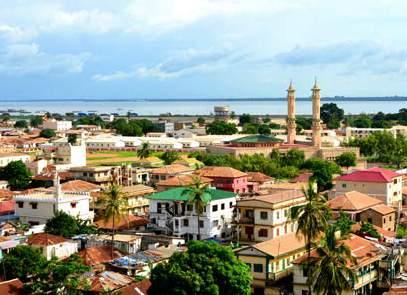
3 minute read
The Interfaith Life Experience in the Gambia: A Shining Example
by USPG
ISSUE 1 2020
Through the USPG Exchanging Places Programme, the Rev’d Obed Baiden discovered how the Gambia’s different faith groups live and work peacefully together
Banjul, The Gambian capital Credit: iStock
The Gambia’s population is 1.8 million, as of the 2013 census. According to CIA statistics, Muslims constitute about 96 percent of the population. The tribes that make up the Gambian people are Wolof, Fula, Mandinka, Jola, Serer, Manjagos, Keroninkas, Mankagne, Blantas, Akus and Maswankas. Of these, the Mankanges, Maswankas, Balantas, Manjagos, Keroninkas and Akus are minority tribes and they make up the Gambia’s Christian communities.
It did not take long for me to have the first cultural and religious shock of my life. On the fourth day of my stay, I was taken round to administer communion to the homebound members of the parish for the first time. In the very first home we visited, the only Christian was an old woman to whom I was meant to administer the sacrament. Her two daughters who lived with her were Muslims. To my surprise, they joined in the viaticum service, sang hymns from the most sacred Ancient and Modern hymnal and prayed the Lord’s Prayer. I discovered that they were Christians but had converted to Islam in order to marry.
I came to realise that there are a lot of expressions of good interfaith relations in the Gambia. The country is filled with people of different backgrounds, but they are a united people. Culturally, spiritually, politically and socially, differences may exist but the people are uniquely one and the same. The peoples of Christianity and Islam live with one another and inter-marry without many challenges. The people of the Gambia live their interfaith relations in their everyday lives: at home, in the farms, at schools and in the offices where they work. Some girls in my Catechism class for confirmation shared with me that they attend an Islamic school and as such are required to wear veils as part of their school uniform. It was even more revealing for me to learn that the Muslim girls in Christian schools remove their veils when they wear their uniforms and put them back on after school.
Gambian names were also interesting for me. As you can imagine, hearing such names as Samuel, David, George or Andrew on the surface told me I was dealing with Christians but names in Gambia do not always tell you the faith a person belongs to. One can have both a Christian first name and surname and be a Muslim. When you flip the equation, you may find the same perhaps unexpected result: a Muhammed or Musa may be sitting in the pew as a Christian. This, I think, is the result of two factors: interfaith marriages and adoption.
Muslims form the greater number of people in the employment of the missionary churches: Anglican, Catholic and Methodist. There is usually no discrimination in the process of engagement and recruitment. As a priest and the chairman of the Parish education board, I have interviewed and employed not less than 20 Muslims. The Bishop of The Gambia’s personal driver and cook are both Muslims. The interfaith relations in this manner stand out as the true witness the Church offers to society. In many ways the minority nature of the Church is not seen and because of this, the Church normally stands on equal footing with the Muslim majority.
The Church - whether in The Gambia or elsewhere - should learn to foster and maintain good interfaith relations, especially during these times of Islamic radicalisation, fundamentalism and terrorism in countries such as Mali, Burkina Faso and Nigeria. Preaching harmonious interfaith coexistence and tolerance should be the focus of the church now more than ever. The church may not see instant growth in terms of numbers but reflecting its presence and the presence of Christ who died for all is necessary. In saying this, our interfaith relations should not be a shy relationship where we keep Christ politely out of the picture.










